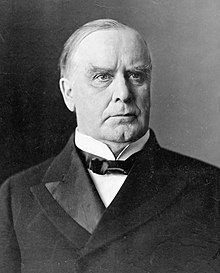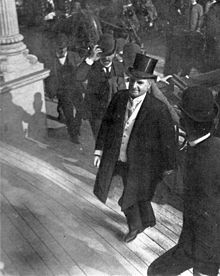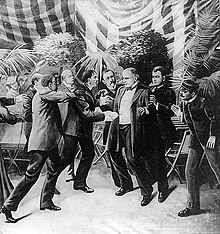William McKinley
William McKinley, Jr. (* 29. January 1843 in Niles , Ohio ; † 14. September 1901 in Buffalo , New York ) was an American politician of the Republican Party and the 25th President of the United States . He held this office from March 4, 1897 to September 14, 1901, when he died of the consequences of an assassination attempt on him eight days earlier.
Career up to the presidency
William McKinley, Jr. was one of nine children of William McKinley (1807-1892) and Nancy Campbell Allison (1809-1897). The parents were of Irish and Scottish descent. On January 25, 1871, he married Ida Saxton , with whom he had two daughters: Katherine (1871–1875) and Ida (1873–1873). Both children died young of typhus .
He took part in the Civil War, in which he marched in 1861 as a soldier and was honorably discharged as a major, where he served temporarily under the later President Rutherford B. Hayes . He fought during the war in the Battle of Antietam , the Battle of Kernstown and the Battle of Cedar Creek, among others . McKinley was elected to the US House of Representatives for Ohio in 1876 . There he became the spokesman for a strict protective tariff policy, with which he corresponded to the wishes of his industrial clientele, which in 1890 caused his party to be severely defeated in the election. Nonetheless, he was elected governor of Ohio in November 1891 . He took up this office in early 1892 and held it until January 1896. During his time as governor, he showed sympathy for trade unions and campaigned for workers' rights.
Presidency (1897–1901)
Even as governor of Ohio, McKinley had established increasing contacts with entrepreneurs, especially with industrialist Mark Hanna . This proposed McKinley to run for president in the 1896 election . From then on Hanna acted as McKinley's election campaign manager, who also managed to raise large sums of donations. In the summer of 1896, the former Ohio governor was named a Republican Party candidate. On election day, November 3, 1896, McKinley was able to comfortably defeat the Democratic candidate , William Jennings Bryan . He won 51 percent of the vote, while Bryan had just under 47 percent. At Electoral College , his lead was even more pronounced at 271 against 176. William McKinley was sworn in as President of the United States on March 4, 1897. He replaced the no longer running Democrat Grover Cleveland . McKinley became the last US president to take an active part in the civil war .
Domestic politics
In contrast to foreign policy, McKinley set relatively little emphasis on domestic politics. For example, he did not have a major legislative agenda. Since the beginning of his tenure, McKinley has been in favor of a reform of import duties . Although he enjoyed a good reputation among the public after taking office, he could not prevent Congress from passing higher tariffs. Although the president was rather skeptical about this, he signed the corresponding bill. He also hardly turned to the problem of so-called trusts in the economy, although these were sometimes massively criticized in public. He therefore distanced himself from his policy as governor, in which he had been close to trade unions. When it comes to economic policy, the president otherwise adhered to the laissez-faire theory. McKinley is considered the first president of the progressive movement (even if his two predecessors already set the tone) . Comprehensive, progressivist-oriented reforms and a stronger fight against trusts only took place under his successor Theodore Roosevelt . Benefiting from the good economic situation around the turn of the century, he relied on a stable currency policy through the gold standard and promoted American industry through protective tariffs and the development of new sales markets in East Asia: Open-Door-Policy to China .
Foreign policy
At the end of the 1890s, the country's more active foreign policy moved more and more into the center of public discussions. This was due in particular to the advance of European colonial powers in Africa and Asia . Under McKinley's presidency, Congress approved the expansion of the naval forces. One of their tasks should be to protect overseas trade. Imperialist currents in American politics were particularly aimed at opening up new economic markets. The President largely agreed with the positions of the imperialists. So he led the United States in the Spanish-American War (1898). In the Peace Treaty of Paris, as in the declaration of war on Spain in April 1898, the United States renounced the annexation of Cuba , but the Philippines , Puerto Rico and Guam fell to them . During McKinley's presidency, the United States annexed the Kingdom of Hawaii and became a colonial power .
In the Philippines, the independence movement that had led to the establishment of the First Philippine Republic ( Philippine-American War , 1899-1902) was then crushed . The suppression of the uprising brought considerable suffering to the civilian population, who suffered from massacres, torture and total lack of law. Between 200,000 and 1.5 million civilians died from war, the suppression of the insurrection and cholera. After that, the Philippines was effectively an American colony until World War II . Overall, the United States embarked on an imperialist course in foreign policy under McKinley's presidency and became a world power. The end of internal colonization in the west of the country also fell into this phase .
Relations with the United Kingdom were also intensified under McKinley . In the following years this led to very close political and economic cooperation between the two countries.
Re-election in 1900 and assassination attempt
In November 1900, McKinley was re-elected for a second term. In the election there was another duel between him and the Democrat William Jennings Bryan, with McKinley this time winning an even clearer victory. 51.6 percent of the electorate voted for McKinley to remain in the White House , while Bryan got around 45 percent of the vote. He was also able to clearly prevail in the electoral committee with 292 against 155 votes. He began his second term of office on March 4, 1901.
On September 6, 1901, he was shot by the anarchist Leon Czolgosz while visiting the Pan-American Exposition , the World's Fair in Buffalo , New York . At first there was still hope that the president would survive the two gunshot wounds he suffered in his chest and abdomen. But on September 14, eight days after the attack, McKinley died of serious injuries at the age of 58. After Abraham Lincoln in 1865 and James A. Garfield in 1881, he was the third assassinated US president and the fifth head of state to die during his tenure. Czolgosz confessed to having shot the president; on October 29, 1901, he was executed on the electric chair .
After his death, McKinley was laid out in the East Hall of the White House, as was Lincoln and later John F. Kennedy . This was followed by a laying out in the Ohio State Capitol. On September 19, 1901, the 25th President of the United States was buried in Canton , Ohio . A memorial was also dedicated to him there.
His successor in the White House was the previous Vice President Theodore Roosevelt , who had only succeeded Garret Hobart , who died during McKinley's first term in March of that year . In response to McKinley's assassination, Congress hired the Secret Service , previously solely responsible for fighting financial crime, to protect the president.
Aftermath
McKinley is considered the average president today by historians and the American public. His lifetime and tenure popularity faded quite quickly after his death, largely due to the administration of his successor, Theodore Roosevelt. This essentially continued foreign policy and, domestically, was much more oriented towards progressivism . While McKinley, in the opinion of most historians, could not set lasting accents in domestic policy (such as a reform program), he began with a reorientation of US foreign policy. From then on, the United States appeared more strongly in world politics than before and began, in cases of doubt, to enforce its interests through the deployment of its armed forces . With McKinley's heightened foreign policy, the era of the Gilded Age , whose US presidents were seen as less powerful, has come to an end. This is due in particular to the fact that after the Civil War and the associated administration of Abraham Lincoln, the American presidents in the last third of the 19th century exercised less influence on politics.
A monument was erected in Buffalo , New York in 1907 in honor of McKinley . In 1917 the highest mountain in North America was named after McKinley. Since 2015 the mountain has been called Denali again . In 1924 and 1934, McKinley's portrait was printed on the $ 500 banknote , which was issued as a means of payment until 1969. There is also a county named after McKinley, McKinley County in New Mexico . McKinley was also the first American presidential candidate to be filmed.
See also
literature
- Raimund Lammersdorf: William McKinley (1897–1901): Entry into world politics. In: Christof Mauch (Ed.): The American Presidents. 6th, continued and updated edition. C. H. Beck, Munich 2013, pp. 245-253.
- Kevin Phillips: William McKinley. (= The American Presidents Series. Ed. By Arthur M. Schlesinger , Sean Wilentz . The 25th President). Times Books, New York City 2003, ISBN 0-8050-6953-4 .
- William H. Armstrong: Major McKinley: William McKinley and the Civil War. Kent State University Press, Kent 2000, ISBN 978-0-87338-657-9 .
- Margaret Leech: In the Days of McKinley. Harper & Brothers, New York 1959: Full text in the Internet Archive .
Web links
- William McKinley in the Biographical Directory of the United States Congress (English)
- Biography on the side of the White House ( Memento of 17 January 2009 at the Internet Archive ) (English)
- American Presidents: William McKinley (1843-1901) , Miller Center of Public Affairs of the University of Virginia (English, editor: Lewis L. Gould)
- The American Presidency Project: William McKinley. University of California, Santa Barbara database ofspeeches and other documents from all American presidents
- William McKinley in the National Governors Association (English)
- William McKinley in the Ohio History Connection Archives
- Life Portrait of William McKinley on C-SPAN , 23 August 1999, 155 minutes (English-language documentation and discussion with the author Sam Vasbinder as well as a curator's tour of the McKinley National Memorial and the neighboring William McKinley Presidential Library and Museum )
- William McKinley in the database of Find a Grave (English)
Remarks
- ^ Raimund Lammersdorf: William McKinley (1897-1901). Entry into world politics. In: Christof Mauch (Ed.): The American Presidents. 5th, continued and updated edition. Munich 2009, pp. 245-253, here: p. 246
- ↑ Kevin Phillips: William McKinley. Pp. 21-23.
- ^ Raimund Lammersdorf: William McKinley (1897-1901). Entry into world politics. In: Christof Mauch (Ed.): The American Presidents. 5th, continued and updated edition. Munich 2009, pp. 245-253, here: p. 247
- ^ Raimund Lammersdorf: William McKinley (1897-1901). Entry into world politics. In: Christof Mauch (Ed.): The American Presidents. 5th, continued and updated edition. Munich 2009, pp. 245–253, here: pp. 247–248
- ^ Raimund Lammersdorf: William McKinley (1897-1901). Entry into world politics. In: Christof Mauch (Ed.): The American Presidents. 5th, continued and updated edition. Munich 2009, pp. 245-253, here: p. 248
- ^ William McKinley: Domestic Affairs . Miller Center of Public Affairs , University of Virginia, accessed April 18, 2018.
- ^ Raimund Lammersdorf: William McKinley (1897-1901). Entry into world politics. In: Christof Mauch (Ed.): The American Presidents. 5th, continued and updated edition. Munich 2009, pp. 245-253, here: pp. 249-250
- ^ Raimund Lammersdorf: William McKinley (1897-1901). Entry into world politics. In: Christof Mauch (Ed.): The American Presidents. 5th, continued and updated edition. Munich 2009, pp. 245-253, here: pp. 250-252
- ^ [Smallman-Raynor, Matthew; Andrew D Cliff (January 1998), "The Philippines Insurrection and the 1902-4 cholera epidemic: Part I - Epidemiological diffusion processes in war", Journal of Historical Geography 24 (1): 69-89, doi: 10.1006 / jhge.1997.0077 Smallmann-Raynor]
- ^ William McKinley: Death of the President . Miller Center of Public Affairs , University of Virginia, accessed April 18, 2018.
- ^ Raimund Lammersdorf: William McKinley (1897-1901). Entry into world politics. In: Christof Mauch (Ed.): The American Presidents. 5th, continued and updated edition. Munich 2009, pp. 245-253, here: pp. 252-253
- ^ William McKinley: Impact and Legacy . Miller Center of Public Affairs , University of Virginia, accessed April 18, 2018.
- ↑ Charles Curry Aiken, Joseph Nathan Kane: The American Counties: Origins of County Names, Dates of Creation, Area, and Population Data, 1950-2010 . 6th edition. Scarecrow Press, Lanham 2013, ISBN 978-0-8108-8762-6 , p. XIV .
- ^ Raimund Lammersdorf: William McKinley (1897-1901). Entry into world politics. In: Christof Mauch (Ed.): The American Presidents. 5th, continued and updated edition. Munich 2009, pp. 245-253, here: p. 248
| personal data | |
|---|---|
| SURNAME | McKinley, William |
| ALTERNATIVE NAMES | McKinley, William Jr. |
| BRIEF DESCRIPTION | American politician, 25th President of the United States (1897–1901) |
| DATE OF BIRTH | January 29, 1843 |
| PLACE OF BIRTH | Niles , Ohio |
| DATE OF DEATH | September 14, 1901 |
| Place of death | Buffalo , New York |









